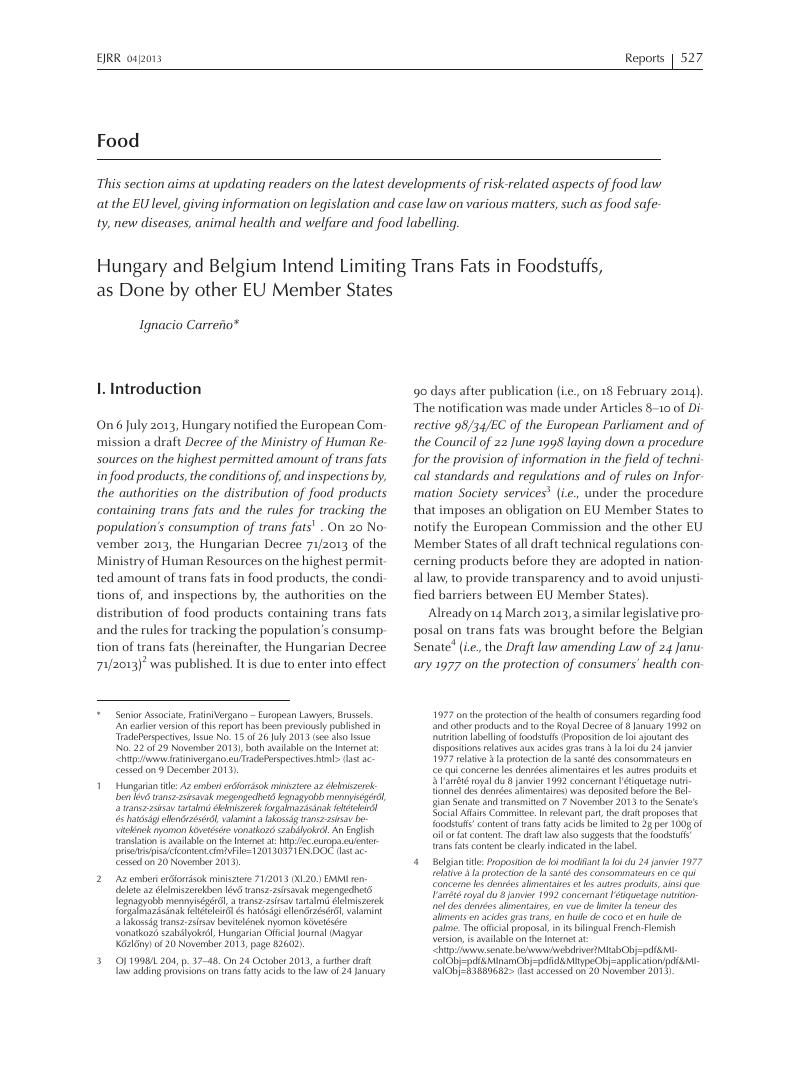No CrossRef data available.
Published online by Cambridge University Press: 20 January 2017

1 Hungarian title: Az emberi erőforrások minisztere az élelmiszerekben lévő transz-zsírsavak megengedhető legnagyobb mennyiségéről, a transz-zsírsav tartalmu élelmiszerek forgalmézésanak feltételeiről és hatósagi ellenőrzéséről, valamint a lakosság transz-zsírsav bevitelének nyomon követésére vonatkozó szábalyokról. An English translation is available on the Internet at: http://ec.europa.eu/enterprise/tris/pisa/cfcontent.cfm?vFile=120130371EN.DOC (last accessed on 20 November 2013).
2 Az emberi erőforrások minisztere 71/2013 (XI.20.) EMMI rendelete az élelmiszerekben lévő transz-zsírsavak megengedhető legnagyobb mennyiségéről, a transz-zsírsav tartalmú élelmiszerek forgalmazásának félteteleiről és hatósági ellenőrzéséről, valamint a lakosság transz-zsírsav bevitelének nyomon követésére vonatkozó szabályokról, Hungarian Official Journal (Magyar Kőzlőny) of 20 November 2013, page 82602).
3 OJ 1998/L 204, p. 37–48. On 24 October 2013, a further draft law adding provisions on trans fatty acids to the law of 24 January 1977 on the protection of the health of consumers regarding food and other products and to the Royal Decree of 8 January 1992 on nutrition labelling of foodstuffs (Proposition de loi ajoutant des dispositions relatives aux acides gras trans à la loi du 24 janvier 1977 relative à la protection de la santé des consommateurs en ce qui concerne les denrées alimentaires et les autres produits et á l'arrêté royal du 8 janvier 1992 concernant l'étiquetage nutritionnel des denrées alimentaires) was deposited before the Belgian Senate and transmitted on 7 November 2013 to the Senate’s Social Affairs Committee. In relevant part, the draft proposes that foodstuffs’ content of trans fatty acids be limited to 2g per 100g of oil or fat content. The draft law also suggests that the foodstuffs’ trans fats content be clearly indicated in the label.
4 Belgian title: Proposition de loi modifiant la loi du 24 janvier 1977 relative à la protection de la santé des consommateurs en ce qui concerne les denrées alimentaires et les autres produits, ainsi que l’arrêté royal du 8 janvier 1992 concernant l’étiquetage nutritionnel des denrées alimentaires, en vue de limiter la teneur des aliments en acides gras trans, en huile de coco et en huile de palme. The official proposal, in its bilingual French-Flemish version, is available on the Internet at: <http://www.senate.be/www/webdriver?MItabObj=pdf&MIcolObj=pdf&MInamObj=pdfid&MItypeObj=application/pdf&MIvalObj=83889682> (last accessed on 20 November 2013).
5 BEK nr 160 af 11/03/2003 (Transfedtsyrebekendtgorelsen), published on 21 March 2003, available on the Internet at: https://www.retsinformation.dk/Forms/R0710.aspx?id=7737 (last accessed on 20 November 2013).
6 267. Verordnung des Bundesministers für Gesundheit über den Gehalt an trans-Fettsäuren in Lebensmitteln Bundesgesetzblatt für die Republik Österreich, Jahrgang 2009, ausgegeben am 20. August 2009, Teil II, 267/2009, available on the Internet at: http://www.ris.bka.gv.at/Dokument.wxe?Abfrage=BgblAuth&Dokumentnummer=BGBLA_2009_II_267 (last accessed on 20 November 2013).
7 See: Danish Ministry for Agriculture, Food and Fisheries, “Transfatty acid content in food”, available on the Internet at: http://www.foedevarestyrelsen.dk/english/Food/Trans%20fatty%20acids/Pages/default.aspx (last accessed on 20 November 2013).
8 Ibid.
9 Steen Stender, Arne Astrup and Jorn Dyerberg, “A trans European Union difference in the decline in trans fatty acids in popular foods – a market basket investigation,” published on 14 September 2012, available on the Internet at: <http://www.ncbi.nlm.nih.gov/pmc/articles/PMC3467660/#R7> (last accessed on 20 November 2013); “Commission drops Danish trans fat case,” EU Food Law Weekly 2007;295 (23 March 2007).
10 Scientific Opinion adopted on 04 December 2009 EFSA Journal 2010; 8(3):1461. Available on the Internet at: <http://www.efsa.europa.eu/en/efsajournal/doc/1461.pdf> (last accessed on 20 November 2013).
11 Full title: Regulation (EU) No 1169/2011 of the European Parliament and of the Council of 25 October 2011 on the provision of food information to consumers, amending Regulations (EC) No 1924/2006 and (EC) No 1925/2006 of the European Parliament and of the Council, and repealing Commission Directive 87/250/EEC, Council Directive 90/496/EEC, Commission Directive 1999/10/EC, Directive 2000/13/EC of the European Parliament and of the Council, Commission Directives 2002/67/EC and 2008/5/EC and Commission Regulation (EC) No 608/2004, OJ 2011/L 304, p. 18–63.